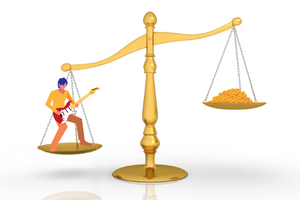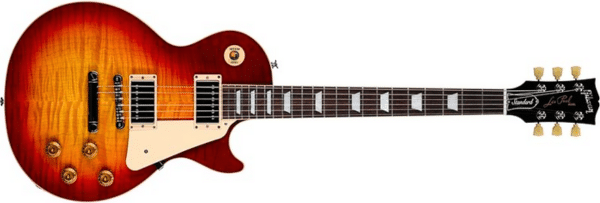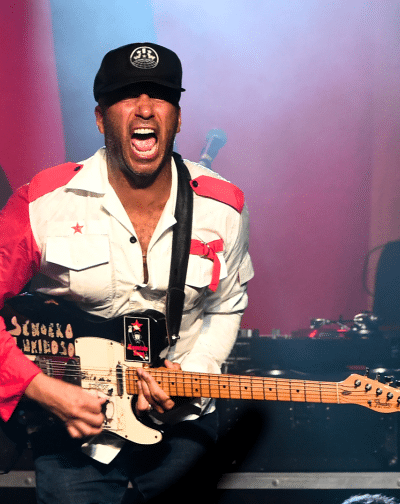The Fender Telecaster, a guitar that has etched its mark in the annals of music history, is often associated with genres like Blues and Rock. But a question often arises among metal enthusiasts: “Is A Telecaster Good For Metal?”
This article delves deep into the Telecaster’s capabilities within the metal genre, exploring its strengths, potential limitations, and its iconic presence in some metal tracks.
You can use the table of contents below to take you to the area that interests you. Click on the little box to open it, and then click on the section of the article you want to read, or you can read from start to finish if you want the full Metal Telecaster experience!
The Short Answer
With the right setup, modifications, and understanding of its unique tonal characteristics, a Telecaster can not only handle metal but can also introduce a fresh sonic perspective to the genre, distinguishing itself from more conventional metal guitars. Its ability to deliver both sharp, clear tones and deep, resonant sounds makes it a versatile choice for metal enthusiasts seeking something different.
Keep On Reading (Below) To Learn More
Why Consider A Telecaster For Metal?

The Telecaster’s unique tonal qualities stem from its construction and design. Its bright and clear sound can cut through dense mixes, providing clarity in intricate metal riffs and solos.
Moreover, its solid body ensures good sustain, which is crucial for some of those solos typical in metal tracks; I’m thinking Steve Vai, Joe Satriani, and John Petrucci songs here, without the whammy bar stuff.
With the right modifications, a Telecaster can be transformed into a metal beast capable of delivering both rhythm and lead tones with precision. We’ll talk more about that later.
Besides, what’s cooler than playing a typically “non-metal” guitar and turning heads with awesome chops?
The Telecaster’s Build And Its Impact On Sound
The Telecaster, with its iconic design, has a unique build that significantly influences its sound. Let’s delve deeper into its construction and understand how it contributes to its tonal characteristics, especially in the context of metal.
Solid-Body Construction
The Telecaster’s solid body is typically made of woods like ash or alder. This solid construction contributes to its bright and resonant sound. The density of the wood provides a natural sustain, making it suitable for those powerful metal riffs and solos. The solid body also aids in reducing unwanted feedback, a crucial factor when playing with high-gain settings typical in metal.
Bolt-On Neck
One of the defining features of the Telecaster is its bolt-on neck. This design, where the neck is bolted onto the body, contributes to its sharp attack and clarity. This feature can be invaluable for metal genres, where precision and clarity in fast-paced riffs are essential.
Single Cutaway Design
The Telecaster’s single cutaway design not only gives it its distinctive look but also provides easy access to the higher frets. This is especially beneficial for metal guitarists who often venture into solo territories on the higher registers.
Bridge Design
The Telecaster’s bridge is another crucial component influencing its sound. Its traditional “ashtray” bridge, combined with the brass saddles, offers a bright and twangy sound. While this might be more associated with country music, it can add a unique character in a metal context, especially when combined with distortion or overdrive.
Advantages Of Using A Telecaster For Metal
The Fender Telecaster, while traditionally associated with genres like country and blues, has found its place in the metal world. Here are some compelling reasons to use a Telecaster for metal:
- Unique Tonal Characteristics: The Telecaster’s bright and clear sound can cut through dense mixes, ensuring that riffs and solos are heard distinctly. This clarity is especially beneficial in metal genres where intricate guitar work is prevalent.
– - Versatility: One of the Telecaster’s strengths is its versatility. It can handle clean tones, crunchy blues, and with the right setup, the heaviest of metal. This makes it an excellent choice for guitarists who play across multiple genres.
– - Durability: Telecasters are known for their robust build. The solid body construction ensures that the guitar can withstand the rigors of aggressive metal playing, from fast-paced riffs to intense live performances.
– - Easy to Modify: The Telecaster’s simple design makes it relatively easy to modify. Whether it’s swapping out pickups for a heavier sound, changing the bridge for better sustain, or adding advanced electronics, the Telecaster is a modder’s dream.
– - Comfort and Playability: With its balanced weight and comfortable neck profile, the Telecaster is easy to play for extended periods. This is crucial during long studio sessions or live performances.
– - Aesthetic Appeal: The Telecaster’s classic design can be a visual standout in the metal genre, which is often dominated by more aggressive-looking guitars. It offers a blend of tradition and rebellion.
– - Affordability: While there are high-end Telecaster models, there are also many affordable options available. This makes it accessible for budding metal guitarists on a budget.
Potential Limitations And Considerations
While the Telecaster offers numerous advantages for metal, it’s essential to be aware of its potential disadvantages. Here’s a breakdown.
- Original Pickups: Traditional Telecasters come equipped with single-coil pickups, which, while clear and bright, might lack the aggressive punch required for heavier metal tones. They can also be prone to interference and noise, especially at high gain settings.
– - Body Resonance: The Telecaster’s solid body provides a bright and resonant tone, which might sometimes be too sharp for some metal sub-genres that prefer a darker, more muted sound.
– - Weight and Ergonomics: Some players might find the Telecaster’s body shape and weight distribution less ergonomic compared to guitars specifically designed for metal, especially during extended playing sessions.
– - Lack of Tremolo System: Most standard Telecasters don’t come with a tremolo system, which can be a limitation for metal guitarists who frequently use dive bombs and other whammy bar techniques.
– - Aesthetic Mismatch: The classic look of a Telecaster might not align with the visual aesthetics of certain metal sub-genres, especially those that lean towards darker, more aggressive themes.
– - Potential for Feedback: The Telecaster’s construction, especially in models with a semi-hollow body, can be more prone to feedback when played at high volumes with high gain.
– - Modding Necessities: To truly harness the Telecaster’s potential for metal, modifications might be necessary, which can be an additional investment in terms of time and money.
Telecaster Models And Their Suitability For Metal


| Telecaster Model | Pros | Cons |
|---|---|---|
| Standard Telecaster | Classic design, versatile sound, suitable for various modifications | Original single-coil pickups might need replacement for heavier tones |
| Telecaster Deluxe | Comes with humbucker pickups, making it immediately more suitable for heavier genres | Slightly heavier body might not be comfortable for all players |
| Telecaster Thinline | Semi-hollow body offers a unique resonance and warmth, adding depth to metal riffs | The semi-hollow design might not provide the aggressive bite some metal players seek |
| American Elite Telecaster | Features noiseless pickups and modern features, making it a blend of classic design and modern functionality | Its higher price point might be a barrier for some |
How To Make A Telecaster More Metal-Ready
The Telecaster, while versatile, might require certain modifications to truly shine in the metal genre. Here’s how you can tweak your Tele to make it more metal-friendly.
- Pickup Replacements: The original single-coil pickups, while clear and bright, might lack the aggressive punch required for metal. Consider swapping them for humbuckers, which offer a fuller and warmer sound. Active pickups, like the EMG series, can also be a great choice, providing a high output and consistent tone that’s perfect for metal.
– - Adjusting the Action: Metal often requires fast and intricate riffs. Lowering the action on your Telecaster can make it easier to play at high speeds, ensuring clarity and precision in your notes.
– - Bridge and Saddle Upgrades: Consider replacing the traditional “ashtray” bridge with a more modern one that offers better intonation and sustain. Additionally, graphite or roller saddles can help avoid string breakage and achieve better tuning stability.
– - Hardware Upgrades: Locking tuners can be a great addition, ensuring your Telecaster stays in tune even after aggressive playing and dive bombs. A string-through-body bridge design can also enhance sustain, which is crucial for those extended metal solos.
– - Electronics and Wiring: Consider adding a push-pull pot or a coil-split switch. This allows for more tonal versatility, letting you switch between single-coil and humbucker tones, giving you the best of both worlds.
Comparing Pickups For Metal Performance

| Pickup Type | Tonal Characteristics | Suitability for Metal | Notes |
|---|---|---|---|
| Single-Coil | Bright, clear, with a sharp attack | Suitable with adjustments | Might need a noise gate for high gain settings due to potential noise |
| Noiseless | Bright and clear like single-coils but with reduced hum and noise | Suitable with adjustments | Great for achieving clarity without the hum typical of single-coils |
| Humbucker | Warm, full-bodied sound with less noise | Highly suitable | Provides a fuller sound, commonly used in metal for its noise reduction |
| Wide Range | Clear highs with a fuller low end compared to traditional single-coils | Highly suitable | Offers a unique tonal palette, combining characteristics of single-coils and humbuckers |
| Active Pickups | Consistent tone with high output | Highly suitable | Requires a battery, often used in modern metal for its clarity and power |
Using High-Gain Amplifiers For A Metal Sound
One of the essential components in achieving a true metal sound is the use of high-gain amplifiers. While the Telecaster can be modified to suit metal, pairing it with the right amplifier is crucial.
- Amplifier Choices: Brands like Mesa Boogie, Marshall, and Peavey offer amplifiers that are tailored for metal. Their high-gain channels provide the aggressive distortion and sustain required for the genre.
– - Tube vs. Solid State: While tube amplifiers are often praised for their warm and organic sound, modern solid-state amps, especially those designed for metal, can deliver a tight and aggressive tone that many metal guitarists prefer.
– - Amplifier Settings: To get the most out of your Telecaster for metal, focus on scooping the mids to taste on your amp, although some players prefer a healthy amount of midrange boost. Additionally, tweaking the bass and treble settings can help in achieving a balanced and powerful metal tone that ensures your guitar cuts through the mix, especially during solos.
– - Speaker and Cabinet Choices: The choice of speakers and cabinets can also influence your sound. Cabinets with Celestion Vintage 30 speakers, for instance, are popular in metal for their aggressive tone.
– - Pedal Pairings with High-Gain Amps: While a high-gain amp can provide the necessary distortion, pairing it with the right pedals can further shape your tone. Overdrive pedals can push the amp’s gain even further, while EQ pedals can help sculpt the perfect metal tone. Noise gate pedals are also essential to eliminate unwanted noise and feedback.
Comparing The Telecaster With Other Metal Favorites

While guitars like the Gibson Les Paul or Ibanez RG series are often the first choices for metal guitarists, the Telecaster offers a unique sonic experience.

The Tele’s bright and clear tones can complement the darker, heavier tones of these guitars, adding a fresh dimension to a band’s overall sound.
Additionally, the Telecaster’s versatility means it can handle other genres with ease, making it a great choice for multi-genre guitarists.
Famous Metal Guitarists Who Use Telecasters

These guitarists have showcased the Telecaster’s versatility and its capability to handle the heavy tones and aggressive playing styles associated with metal.
John 5 (Rob Zombie, Marilyn Manson)

An incredibly versatile guitarist, John 5 has been known to use various Telecaster models, especially in his solo work, showcasing the instrument’s range from country licks to heavy metal riffs.
Jim Root (Slipknot, Stone Sour)

Jim Root has his signature Fender Telecaster, which he designed to cater to his heavy playing style. It’s equipped with active humbuckers and has a minimalist look, reflecting his preference for functionality over aesthetics.
Tom Morello (Rage Against The Machine, Audioslave)

While Morello is often associated with his “Arm The Homeless” custom guitar, he has been seen using a Telecaster, especially in his early years with Rage Against the Machine.
Richie Kotzen (Solo, The Winery Dogs)

A virtuoso guitarist with a diverse style, Kotzen has his signature Fender Telecaster model. It’s equipped with large jumbo frets and DiMarzio pickups, making it suitable for both his soulful blues licks and heavier riffs.
Do Your Homework Before You Buy!

When considering a Telecaster for metal or any other genre, it’s crucial to be aware of some potential pitfalls. Always do your due diligence to find the Telecaster plays and sounds best.
Try similar Telecasters in local music stores through an amplifier similar to what you will be using.
- Counterfeit Models: The popularity of the Telecaster has led to a surge in fake models. While visually similar, these knock-offs often use inferior materials and craftsmanship, leading to subpar sound and playability.
– - Overpriced Vintage Models: The allure of vintage Telecasters can be tempting. However, not all old Telecasters are “golden era” instruments. Some might be overpriced based on age alone, without offering any significant tonal or playability advantages.
– - Misleading Descriptions: When purchasing online, be wary of vague or misleading descriptions. Terms like “Telecaster-style” or “Tele-inspired” might indicate that the guitar is not an authentic Fender Telecaster or a similar high-quality model.
– - Hardware Inconsistencies: Some Telecasters, especially those not from Fender’s main lines, might have non-standard hardware sizes or placements. This can make compromise functionality and make future modifications or replacements challenging.
– - Over-Reliance on Branding: While the Fender name carries weight, sometimes, lesser-known brands or custom builders might offer a Telecaster model that suits your metal needs better than a mainstream option.
Key Takeaways

Here are three important things to remember from this article.
- Telecasters, with the right modifications, can be formidable instruments for metal.
- Pickups can drastically enhance the Telecaster’s sound for metal.
- The Telecaster is versatile enough to handle metal and other genres with equal prowess.
Are You Qualified To Make Guitar Adjustments Or Modifications?

It’s great to work on your guitars, especially if you have a lot of them, but you should always be aware of your limitations.
Adjusting things like an electric guitar’s string height (action) or pickup height can be straightforward. Still, some adjustments require the proper training and experience, like adjusting a guitar’s truss rod.
When you doubt your ability to adjust, repair, or modify your guitar, it’s always best to bring it to a competent guitar technician or luthier (guitar designer & builder). You can permanently damage your guitar, and it might never play and sound right again!
Making modifications to your guitar can void its manufacturer’s warranty and cause permanent damage to the instrument. Certain modifications are irreversible, so you may be stuck with them, even if you desperately want to restore the guitar to its original condition!
I learned that the hard way over the years until I did a three-year apprenticeship in a guitar repair shop. Now I have my own home workshop with the proper training and equipment to safely maintain and repair all my instruments.
Remember: “When In Doubt, Send It Out!”
Frequently Asked Questions

Here are some of the questions I get asked about Telecasters and Metal.
If your question does not appear here, please put it in the comments, and I will get right back to you with an answer.
What Guitar Is Most Used In Metal?
The most commonly used guitars in metal are the Gibson Les Paul, Gibson SG, and various models from brands like Ibanez, Jackson, ESP, and Schecter.
What Is The Best Setup For A Metal Guitar?
The best setup for a metal guitar includes high-output pickups (often active), a fast and comfortable neck profile, a double-locking tremolo system for tuning stability, and a setup that favors low action without fret buzz.
Additionally, heavier gauge strings and drop or alternate tunings are common for achieving deeper, heavier tones.
What Gauge Strings Do Metal Guitarists Use?
Metal guitarists typically use heavier gauge strings to achieve a thicker and more resonant tone, especially when using drop or alternate tunings. Common gauges for metal range from .010-.052 to .012-.060, though some guitarists, especially those in extreme sub-genres or using extended-range guitars, might opt for even heavier sets.
What Pick Do Metal Guitarists Use?
Metal guitarists often prefer thicker picks, ranging from 0.88mm to 1.5mm, for better attack and precision. Popular choices include the Dunlop Tortex, Dunlop Jazz III, and the Jim Dunlop Max-Grip series. The pick’s material and shape can also influence tone and playability.
How Does The Telecaster Handle Drop Tunings Common In Metal?
A Telecaster can handle drop tunings effectively with a proper setup, including adjusting the truss rod and intonation.
Are There Seven Or Eight-String Telecaster Models For Extended-Range Metal Playing?
While not common, some custom builders and brands offer extended-range Telecaster models.
How Does The Telecaster’s Scale Length Affect Its Metal Sound?
The Telecaster’s 25.5″ scale length offers a bright and tight sound, beneficial for clarity in metal riffs.
Can I Use A Telecaster With A Floyd Rose For Metal?
Although rare, some Telecasters come equipped with or can be modified to include a Floyd Rose for dive bombs and other whammy techniques.
How Does The Telecaster Handle Palm Muting Techniques Common In Metal?
The Telecaster’s bridge design accommodates palm muting effectively, ensuring tight and rhythmic metal riffs.
Are There Specific Telecaster Models Designed For Metal?
While traditional Telecasters aren’t specifically for metal, some signature models, like Jim Root’s Telecaster, are tailored for heavier genres. Always try a variety of Telecaster models to find the one that works best for your needs!
Final Thoughts

The question, “Is a Telecaster good for metal?” has been a topic of debate among guitar enthusiasts for years. At first glance, the Telecaster, with its iconic design and association with genres like Country and Blues, might seem an unlikely choice for the aggressive world of metal.
However, as we’ve explored in this article, this versatile instrument has carved out a niche for itself in the metal community. With the right modifications, setup, and understanding of its unique tonal characteristics, the Telecaster can not only handle the demands of Metal but also introduce a fresh sonic perspective to the genre.
One of the Telecaster’s primary strengths lies in its clear and bright tonal output, ensuring that riffs and solos cut through dense mixes. Its solid body construction, combined with its bolt-on neck, offers a sharp attack and clarity that can be invaluable in metal genres, where precision is paramount. Moreover, its simple design makes it ideal for modifications, allowing players to tailor it to their specific metal needs, from pickup replacements to hardware upgrades.
However, like any instrument, the Telecaster comes with its set of considerations. Its traditional single-coil pickups might require swapping for a more aggressive sound, and its classic design might not align with the visual aesthetics of certain metal sub-genres. But with awareness and the right approach, these potential limitations can be addressed, making the Telecaster a formidable tool in a metal guitarist’s arsenal.
In the end, the Telecaster’s presence in the metal world is a testament to its versatility and enduring appeal. Whether you’re a budding metal guitarist or a seasoned player looking for a fresh sound, the Telecaster, with its unique blend of tradition and adaptability, might just be the unexpected answer you’re looking for.

Here’s a video from Agufish, who demos the sound of a Vintera 50s Telecaster for playing metal. Be sure to keep watching until after the guitar review to hear more of the demo without a background track.
What To Read Next ➡ Is A Telecaster Good For Rock? Get the Answer Here!
Related Article ➡ What Genre Is A Telecaster Good For? (It’s Not Just Country)
Tell Me What You Think

Please leave a comment below if you enjoyed this article, have any questions about Telecasters for Metal, or want to give your point of view. I will be happy to help you.
- What’s your favorite Metal guitar? Why?
- Do you use a Telecaster for Metal? What kind of pickups does it have?
- After reading this article, are you considering getting a Telecaster to play Metal?
- What else is on your mind?



Wow, what an incredibly thorough and informative article! I’m truly impressed by the depth of analysis you’ve provided on the Telecaster’s suitability for metal. It’s fascinating to see how the Telecaster’s unique tonal qualities and construction contribute to its potential in the metal genre. The comparison of different pickup types and modifications for achieving a metal-ready Telecaster is particularly insightful. Your inclusion of real-world examples, like famous metal guitarists who use Telecasters, adds a practical and relatable dimension to the discussion. I’d love to know if there are any specific Telecaster models you would recommend for someone looking to explore metal? Keep up the fantastic work!
Hi, Ashley
Thank You for your comments!
Check out the Jim Root Signature Telecaster model. It has a mahogany body, a 12″-radius fingerboard, and EMG active humbucking pickups. The guitar plays like a dream and is really rad-sounding!
Rock On! 🤘
Frank 🎸
Hello!
I’m quite new to the world of guitars and especially metal music, but I’ve been curious to learn more. I came across your article about using a Fender Telecaster for metal, and it really caught my attention. I’ve always associated Telecasters with genres like blues and rock, so the idea of using them for metal is intriguing. I noticed you mentioned modifications and setups to make it work.
Could you explain a bit more about what kind of modifications someone might need to make to a Telecaster to use it effectively in a metal context? And how challenging is it for someone who’s not very experienced with guitar modifications to make these changes?
Thank you for sharing your insights!
Hi, Skamalka
That you for your comments!
The most common Telecaster modification for playing Metal is changing the single-coil pickups to humbuckers (double-coil design). This typically gives a higher output and less trebly sound.
Active humbucking pickups are ideal for many subgenres of Metal because they have a more aggressive tone, especially with drop tunings.
Rock On! 😎
Frank 🎸